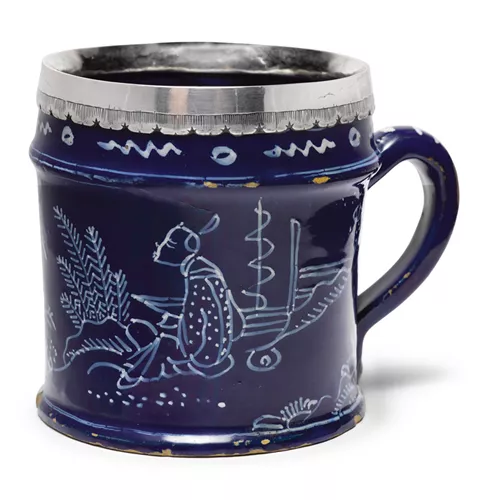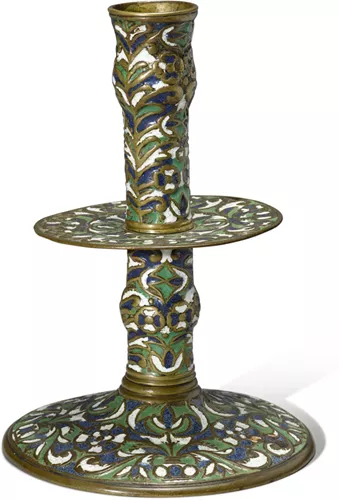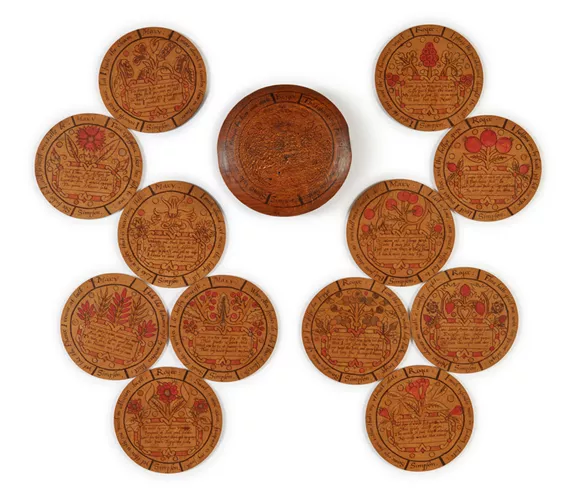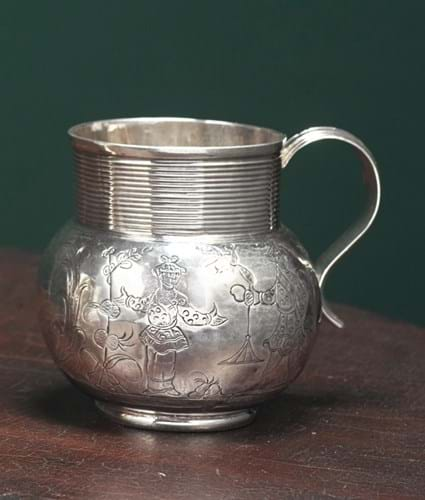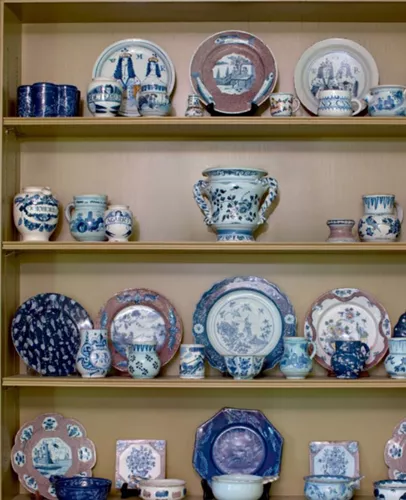
Like other leading US collectors of their generation, the Vogels furnished their Milwaukee home in textbook early colonial style mixing New England furniture from the Pilgrim century with the sort of Old World objects that would have been in a typical high-status American home.
The couple bought tin-glazed earthenwares and related ceramics from UK dealers such as Jonathan Horne, Alistair Sampson and Garry Atkins and Stuart and Commonwealth period silver from How of Edinburgh, Shrubsole and SJ Phillips.
Two catalogues have been produced for the sale on January 19: the British ceramics to be offered in 131 lots as Volume I with Volume II comprising a mix of early Americana related and European domestic objects bring the total number of lots to 484. Most (345) of the works in this sale are offered with estimates below $5000. Pictured here are half a dozen highlights:
1. Armorial tankard
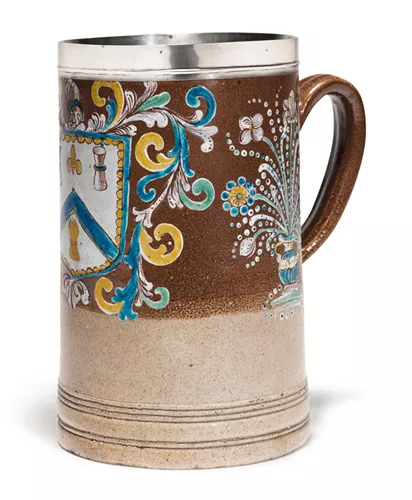
This tankard is decorated with the coat-of-arms of the Worshipful Company of Bricklayers and Tylers and estimated at $10,000-15,000.
Only half a dozen pieces are known that share the same body type as this English brown stoneware armorial tankard. All appear to have been produced in London, likely Fulham, with enamel decoration from the same workshop. With a capacity for half a gallon of ale, this tankard is decorated with the coat-of-arms of the Worshipful Company of Bricklayers and Tylers and other floral flourishes. The silver mount was added in the 19th century – struck for Edward Witham, London, 1824. Acquired by the Vogels from Jonathan Horne in 1988, it is estimated at $10,000-15,000.
2. Staffordshire slipware bragget pot
This 13in (33cm) Staffordshire slipware bragget pot, estimated at £40,000-60,000 includes the inscription The Best Is Not Too Good For You and the date 1697. It was acquired by the Vogels from Jonathan Horne in 1980. The word ‘bragget’ derives from the Old English word meaning malt and references an ancient British liquor that comes from fermenting honey and beer together.
3. English 'Persian blue' delft mug
The Vogel collection includes many examples of Persian Blue English delft that is decorated in white over a deep blue glaze. This 4in (10cm) mug c.1680, painted with a continuous chinoiserie scene and mounted in silver, was bought from Jonathan Horne in 1978. Estimate £8000-12,000.
4. 'Surrey enamel' candlestick
This exceptional candlestick belongs to a small group of cast and enamelled brass wares, made in the second half of the 17th century. All are distinguished by their method of production: unlike champlévé or cloisonné decoration, the enamelled fields were cast in the mould.
For many years these were referred to as 'Surrey enamels' but evidence now makes a strong case for their reattribution to the London workshops of Anthony Hatch and Stephen Pilcherd - prominent members of the Armourers' and Braziers' Company. A nearly identical pair of candlesticks is in the collection of the Metropolitan Museum of Art. Acquired from a London private collection in 2003, it is estimated at $25,000-35,000.
5. Sycamore 'marriage' trenchers c.1625
These English painted sycamore trenchers were a wedding gift to Roger Simpson and his bride Mary in 1625 from their cousin. Each plate has an inscription that includes either the bride's or groom's name alongside verses about love, sex and marriage. The lid of the box is inscribed The laboring bee that sucks of me such sweet, shows unto man, what things for him are meet.
Roundels such as this - used at the end of dinner for desserts and wordy entertainment - were typically made in sets of eight or 12, and very occasionally 24, and kept in circular roundel boxes. They appear to have become widespread across society, enough for John Donne to joke in 1669 that "[Aesop's] fables and fruit-trenchers teach as much."
Very few sets survive in their original boxes. This group of 12, acquired from New York dealer James Robinson in 1987, are estimated at $15,000-25,000.
6. Stuart chinoiserie silver mug
This James II silver mug (London 1685) is one of a number of pieces of Stuart silver in the Vogel collection carrying chinoiserie decoration. The form is particularly unusual although is known from a handful of other silver vessels and mugs from the period made in brown and red stonewares by the Elers brothers and John Dwight of Fulham. Estimate £8000-12,000.



